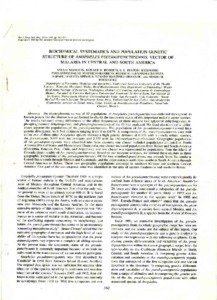Biochemical systematics and population genetic structure of Anopheles pseudpunctipennis, vector of malaria in central and South America.
Manguin, S y Roberts, Donald R. y Peyton, E.L. y Fernández Salas, Ildefonso y Barreto, M. y Fernández, R.
(1995)
Biochemical systematics and population genetic structure of Anopheles pseudpunctipennis, vector of malaria in central and South America.
American journal of tropical medicine and hygiene, 53 (4).
pp. 362-377.
ISSN 0002-9637
![[img]](http://eprints.uanl.mx/366/1.hassmallThumbnailVersion/Biochemical_systematics_and_population_genetic_structure_of_Anopheles_pseudopunctipennis%2C_vector_of_malaria_in_Central_and_South_America.pdf)  Vista previa |
|
PDF
Biochemical_systematics_and_population_genetic_structure_of_Anopheles_pseudopunctipennis,_vector_of_malaria_in_Central_and_South_America.pdf
Download (1MB)
| Vista previa
|
Resumen
An electrophoretic survey of 42 populations of Anopheles pseudopunctipennis collected throughout its known geographic distribution was performed to clarify the taxonomic status of this important malaria vector species. The results indicated strong differences in the allele frequencies of three enzyme loci (glycerol dehydrogenase, 6-phosphogluconate dehydrogenase, and phosphoglucomutase) of the 33 loci analyzed. No fixed electromorphic differences separate the populations of An. pseudopuntipennis. The populations of An. pseudopunctipennis showed little genetic divergence, with Nei distances ranging from 0 to 0.079. A comparison of An. pseudopunctipennis data with either one of three other Anopheles species showed a high genetic distance of 0.335 with a closely related species, An, franciscanus; 0.997 with An. crucians, and 2.355 with An, (Nyssorhynchus) albimanus. Geographic populations of An. pseudopunctipennis were classified into three clusters; one cluster included populations collected in North America (United States and Mexico) and Guatemala, one cluster included populations from Belize and South America (Colombia, Ecuador, Peru, Chile, and Argentina); and one cluster was represented by populations from the Island of Grenada (type-locality of An. pseudopunctipennis). Based on our isozyme analyses, we defined these clusters as three geographic populations of An. pseudopunctipennis. Of the two mainland populations, one extends from the southern United States south through Mexico and Guatemala, and the other extends north from southern South America through Central America to Belize. These two geographic populations converge in southern Mexico and northern Central America. One part of the convergence zone was identified in the area of eastern Guatemala and southern Belize.
| Tipo de elemento: |
Article
|
| Materias: |
Q Ciencia > Q Ciencias en General |
| Divisiones: |
Ciencias Biológicas |
| Usuario depositante: |
Admin Eprints
|
| Creadores: |
| Creador | Email | ORCID |
|---|
| Manguin, S | NO ESPECIFICADO | NO ESPECIFICADO | | Roberts, Donald R. | NO ESPECIFICADO | NO ESPECIFICADO | | Peyton, E.L. | NO ESPECIFICADO | NO ESPECIFICADO | | Fernández Salas, Ildefonso | ifernand1@hotmail.com | NO ESPECIFICADO | | Barreto, M. | NO ESPECIFICADO | NO ESPECIFICADO | | Fernández, R. | NO ESPECIFICADO | NO ESPECIFICADO |
|
| Fecha del depósito: |
26 Ene 2011 15:38 |
| Última modificación: |
19 Nov 2022 22:56 |
| URI: |
http://eprints.uanl.mx/id/eprint/366 |
Actions (login required)
 |
Ver elemento |


 Descargar estadísticas
Descargar estadísticas Descargar estadísticas
Descargar estadísticas

